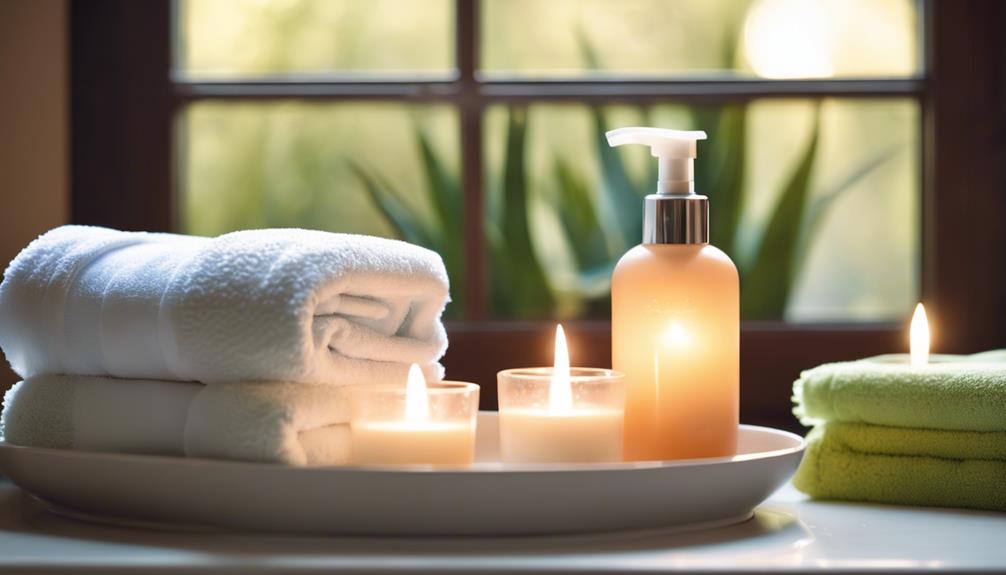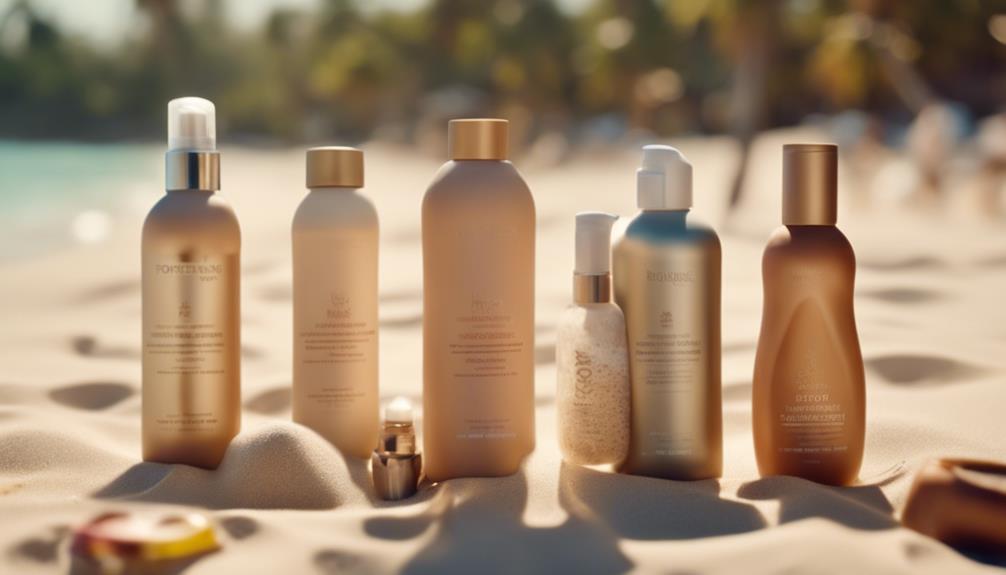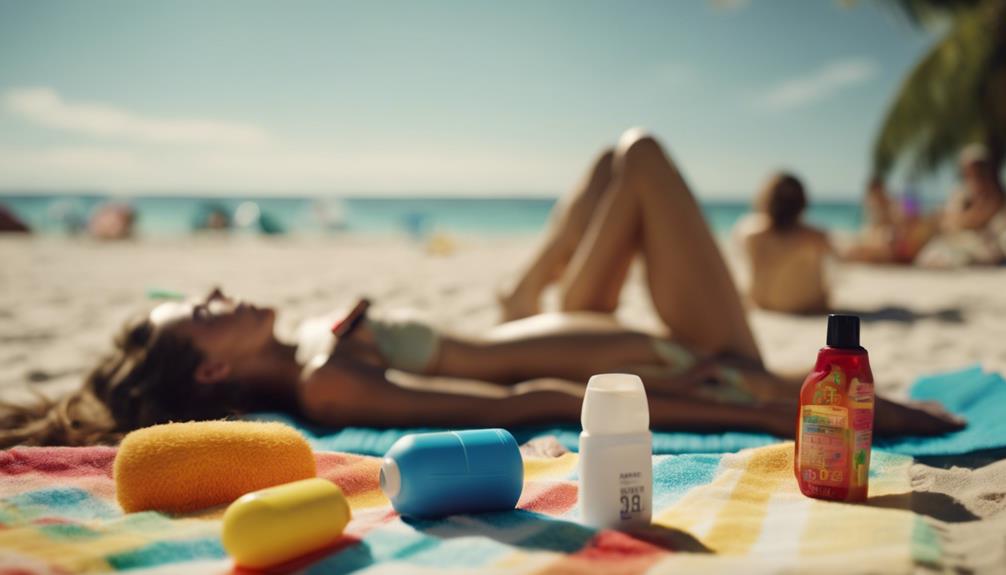Custom tanning times depend on your skin type. If you've got fair skin, you'll want to stick to just 5-10 minutes to avoid looking like a lobster. Beige skin can go for 10-15 minutes, while medium skin starts at the same but can gradually go longer. Got olive skin? You can handle 15-20 minutes. Dark skin folks can rock it for 20-30 minutes, but remember to ease into it! Don't forget to prep your skin with exfoliation and hydration, or you might end up with a patchy look. Want to know more about getting that perfect glow? There's more to unpack!
Key Takeaways
- Fair skin should start with 5-10 minutes in the tanning bed to avoid burns.
- Beige skin can safely increase tanning time to 10-15 minutes per session.
- Medium skin can begin with 10-15 minutes and gradually extend duration as needed.
- Olive skin tolerates 15-20 minutes, allowing for deeper color without burning.
Skin Types Overview
Understanding your skin type is essential for tailoring your tanning experience to achieve the best results while minimizing the risk of damage.
So, what's your skin type?
If you've got fair skin, you'll need to be super careful, starting with just 5-10 minutes in the tanning bed.
Beige skin? Gradually bump it up to 10-15 minutes.
Medium skin folks can kick things off with 10-15 minutes too, while olive skin can go for 15-20.
Dark skin? Lucky you! You can handle 20-30 minutes, but still take it slow.
Remember, everyone's skin is different, and knowing your type lets you avoid those nasty burns.
No one wants to walk around looking like a lobster, right?
Tanning Time Recommendations

To achieve the best tanning results while minimizing risks, it's crucial to follow specific time recommendations based on your skin type.
If you've got fair skin, stick to just 5-10 minutes in the tanning bed—too much, and you'll look like a lobster!
For beige skin, aim for 10-15 minutes, and medium skin folks should start around 10-15 minutes too, gradually increasing.
Olive skin can handle 15-20 minutes, while dark skin can bask for 20-30 minutes.
Just remember, it's all about building that base tan, not turning into a crispy critter overnight!
Keep an eye on how your skin reacts, and don't forget to slather on some sunscreen if you're venturing outside afterward.
Happy tanning!
Skin Preparation Techniques

Before you hit the tanning bed, prepping your skin properly can make all the difference in achieving an even, lasting tan. You don't want to end up looking like a patchy pizza, right? Here are three essential skin prep tips to get you started:
- Exfoliate: Scrub your skin 24 hours before tanning to remove dead skin cells. It'll help your tan go on smoother, trust me!
- Moisturize: Hydrate your skin daily leading up to your session. Well-hydrated skin accepts tan like a sponge!
- Avoid Certain Products: Steer clear of retinoids and heavy oils right before tanning, as they can mess up your tan.
With these tips, you'll be ready to glow like the sun! Happy tanning!
Post-Tanning Care Essentials

After achieving that perfect tan, taking care of your skin becomes just as important to maintain its glow and health. You don't want all that hard work to fade away, right?
First, use a gentle soap to wash off any tanning products. No scrubbing like you're trying to remove paint! Pat your skin dry with a soft towel instead.
Next, slather on a good post-tanning moisturizer to keep your skin hydrated and your tan looking fresh. Ever heard of tan extenders? They're great for prolonging that sun-kissed look!
And don't forget to drink plenty of water—your skin will thank you!
Safety Measures for Tanning

Starting your tanning journey with safety in mind is essential to protect your skin and enhance your results. You want that gorgeous glow without the nasty burns, right?
Here are a few tips to keep you safe while tanning:
- Keep it short: Start with short sessions, and gradually increase the time. Your skin will thank you later!
- Protect those peepers: Always wear protective goggles. Your eyes deserve some love too, so don't skimp on this one!
- Moisturize: Use a good indoor tanning lotion to keep your skin hydrated. Dry skin is like a sad desert—no one wants that!
Effective Use of Bronzer Lotions

Choosing the right bronzer lotion tailored to your skin type can greatly enhance your tanning results and give you that natural-looking glow. Seriously, you want something that complements your unique tone!
Before you slather it on, don't forget to exfoliate your skin. This little step makes a huge difference in how well the bronzer sticks.
Now, here's a fun tip: always do a patch test first, especially if you've got sensitive skin. Nobody wants a surprise orange patch, right?
Also, keep your skin hydrated; it'll help you achieve that gorgeous tan you're after.
Exploring Healthy Tanning Alternatives

If you're looking for a safe way to achieve a sun-kissed glow without the risks of UV exposure, sunless tanners are a fantastic option. They give you that bronzed look without the burn—what's not to love? Here are a few fun alternatives to explore:
- Spray Tans: Quick and easy, these give you an instant glow. Just remember to stand still!
- Tanning Lotions: They're customizable, so you can control how dark you go. Plus, they smell amazing!
- Bronzer Sticks: Perfect for quick touch-ups, they can help you look like you just got back from the beach.
After your tan, don't forget to hydrate your skin! Keep it moisturized for that long-lasting glow.
Happy tanning!
Frequently Asked Questions
Can I Tan if I Have Skin Conditions Like Eczema?
If you have skin conditions like eczema, you should consult a dermatologist before tanning. They can advise on safe methods and necessary precautions, ensuring your skin stays healthy while achieving the desired tan.
How Often Should I Tan for Optimal Results?
'Slow and steady wins the race.' For ideal results, tan 1-2 times a week, gradually increasing exposure. Monitor your skin's response, and always prioritize safety to achieve that perfect, glowing tan without damage.
Are There Specific Foods That Enhance Tanning?
While no specific foods guarantee enhanced tanning, a diet rich in antioxidants, like fruits and vegetables, can improve skin health. Staying hydrated also helps maintain skin elasticity, which can support a more even tan.
What Are the Signs of Overexposure While Tanning?
"Too much sun can burn a hole in your plans." Watch for redness, blistering, or peeling skin; these signs indicate overexposure while tanning. If you experience discomfort, it's time to stop and let your skin recover.
Can I Use Regular Lotions Instead of Tanning-Specific Products?
You can use regular lotions, but they might not provide the best results. Tanning-specific products contain ingredients that enhance color and hydration, ensuring a more even and lasting tan while protecting your skin.
Conclusion
So, there you have it! Tanning isn't just about soaking up the sun; it's like baking a cake—you need the right ingredients and timing.
By knowing your skin type and following the tips we shared, you can achieve that gorgeous glow without turning into a lobster!
Remember, keeping your skin healthy is the real goal here.
So grab your sunscreen, enjoy the process, and let your tan shine brighter than your favorite summer playlist!










